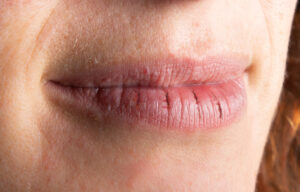December 17, 2021 | Black & Kletz Allergy
 An inflammatory appearance of the lips is termed cheilitis. This inflammation of the lips may cause redness, dryness, and/or scaling on the lips. It can also be associated with swelling, and in severe cases, blisters and/or sores may develop on the lips. Cheilitis can be either acute or chronic in nature. Although most cases of cheilitis are due to sun exposure, allergies involving the lips are quite common. Allergic cheilitis is sometimes referred to as eczematous cheilitis which is also called lip dermatitis.
An inflammatory appearance of the lips is termed cheilitis. This inflammation of the lips may cause redness, dryness, and/or scaling on the lips. It can also be associated with swelling, and in severe cases, blisters and/or sores may develop on the lips. Cheilitis can be either acute or chronic in nature. Although most cases of cheilitis are due to sun exposure, allergies involving the lips are quite common. Allergic cheilitis is sometimes referred to as eczematous cheilitis which is also called lip dermatitis.
Causes:
- Atopic dermatitis – Usually a genetically determined generalized inflammation of the skin. Can affect the lips causing cheilitis.
- Irritant contact cheilitis – A reaction of the lips to cosmetics, foods, and/or environmental irritants.
- Allergic contact cheilitis (ACC) – A delayed hypersensitivity reaction to chemicals which causes an eczema-like reaction on the lips. Allergic sensitization to chemicals found in lipsticks, lip balms, toothpastes, dental materials, medications, metals, foods, and/or nail polish can cause ACC.
- Contact urticaria – A hive-like reaction over the lips usually caused by certain flavorings in toothpastes, foods, and/or food additives (e.g., preservatives, coloring agents).
Clinical Features:
Both the upper and lower lips are usually involved at the same time. They may appear dry, red, cracked, peeling, fissuring, and/or swollen. There may also be itching, burning, and/or pain of the lips in some individuals. The angles of the mouth may exhibit crusting at the corners. If the angles of the mouth are affected, it is called angular stomatitis or angular cheilitis. In addition, the skin around the mouth may also be red and dry. This involvement of the skin around the mouth is termed perioral dermatitis.
Diagnosis:
It is important for the board certified allergist to perform a comprehensive history of the onset, duration, and severity of the symptoms, as well as any possible temporal association with exposure to the known triggers in order detect the offending agent responsible for the condition. A complete physical examination is also performed.
When the history and physical examination are not definitive in identifying the causative agent, patch testing may be necessary. This procedure involves the application of the common chemical sensitizers in individual small rectangular patches that are placed on the skin. These patches should remain in constant contact with the skin for 48 hours. Test results are interpreted after the removal of the patches at 48 hours and again between 72 and 96 hours after their application. Redness, swelling, blistering, and/or oozing at the site of the contact of the test agent confirms a sensitivity to that particular chemical.
Contact urticaria may sometimes require prick skin testing with foods and/or chemicals to establish the diagnosis.
The following causative agents are usually identified as the triggers for allergic contact cheilitis:
- Oral hygiene products (e.g., toothpastes, mouthwash, dental floss)
- Lipsticks and other lip care products (e.g., lip balm, sunscreen, Chapstick)
- Nail polish substances
- Fragrances (e.g., Balsam of Peru)
- Rubber or latex products
- Sunscreen
- Certain foods (e.g., cinnamon, mango)
- Metals (e.g., nickel, gold, cobalt) – Found in orthodontic devices, musical instruments, etc.
- Propylene glycol
- Chronic lip picking and/or lip licking
- Certain medications (e.g., bacitracin, neomycin)
- Weather-related conditions (e.g., wind, cold)
Treatment:
Topical anti-inflammatory medications such as corticosteroids or non-steroidal agents such as Elidel and Eucrisa ointments can help relieve the symptoms of lip cheilitis/dermatitis. Non-irritating and fragrance-free emollients containing petrolatum, shea butter, mineral oil, ceramides, and/or sun-protective ingredients, (e.g., zinc oxide, titanium oxide) are useful to keep the lips moisturized.
Strict avoidance of exposure to the offending agent at all times is essential, as desensitization to the contact allergens has not been shown to be effective.
The board certified allergists at Black and Kletz Allergy have been diagnosing and treating allergies and asthma for more than 50 years in the Washington, DC, Northern Virginia, and Maryland metropolitan area. We see both pediatric and adult patients. We have offices in Washington, DC, McLean, VA (Tysons Corner, VA), and Manassas, VA. We have on-site parking at each of our 3 locations. Our Washington, DC and McLean, VA offices are Metro accessible. Black & Kletz Allergy offers a free shuttle service between our McLean, VA office and the Spring Hill metro station on the silver line. If you suffer from allergies to your lips or face, please call us to make an appointment. You may also click Request an Appointment and we will respond within 24 hours by the next business day. Black & Kletz Allergy is dedicated in providing the most state-of-the-art allergy treatment in a caring, friendly, and professional environment.












